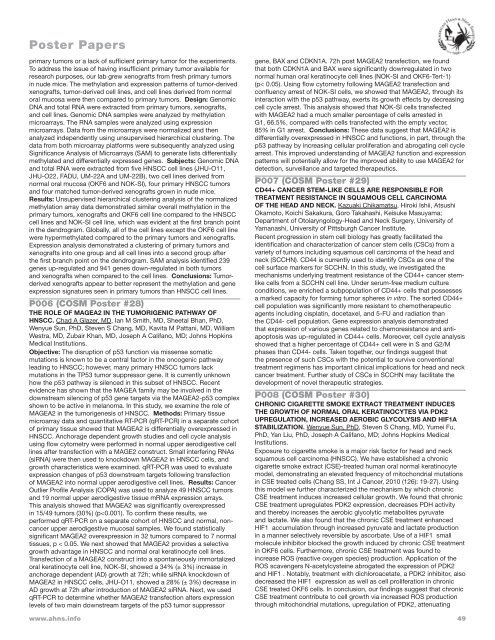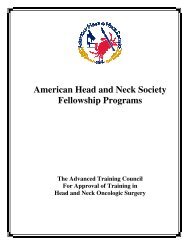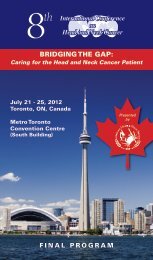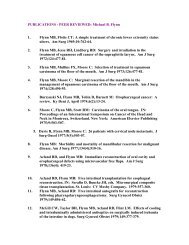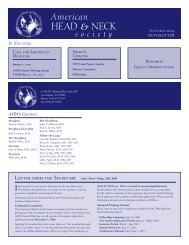Download - American Head and Neck Society
Download - American Head and Neck Society
Download - American Head and Neck Society
You also want an ePaper? Increase the reach of your titles
YUMPU automatically turns print PDFs into web optimized ePapers that Google loves.
Poster Papers<br />
primary tumors or a lack of sufficient primary tumor for the experiments.<br />
To address the issue of having insufficient primary tumor available for<br />
research purposes, our lab grew xenografts from fresh primary tumors<br />
in nude mice. The methylation <strong>and</strong> expression patterns of tumor-derived<br />
xenografts, tumor-derived cell lines, <strong>and</strong> cell lines derived from normal<br />
oral mucosa were then compared to primary tumors. Design: Genomic<br />
DNA <strong>and</strong> total RNA were extracted from primary tumors, xenografts,<br />
<strong>and</strong> cell lines. Genomic DNA samples were analyzed by methylation<br />
microarrays. The RNA samples were analyzed using expression<br />
microarrays. Data from the microarrays were normalized <strong>and</strong> then<br />
analyzed independently using unsupervised hierarchical clustering. The<br />
data from both microarray platforms were subsequently analyzed using<br />
Significance Analysis of Microarrays (SAM) to generate lists differentially<br />
methylated <strong>and</strong> differentially expressed genes. Subjects: Genomic DNA<br />
<strong>and</strong> total RNA were extracted from five HNSCC cell lines (JHU-O11,<br />
JHU-O22, FADU, UM-22A <strong>and</strong> UM-22B), two cell lines derived from<br />
normal oral mucosa (OKF6 <strong>and</strong> NOK-SI), four primary HNSCC tumors<br />
<strong>and</strong> four matched tumor-derived xenografts grown in nude mice.<br />
Results: Unsupervised hierarchical clustering analysis of the normalized<br />
methylation array data demonstrated similar overall methylation in the<br />
primary tumors, xenografts <strong>and</strong> OKF6 cell line compared to the HNSCC<br />
cell lines <strong>and</strong> NOK-SI cell line, which was evident at the first branch point<br />
in the dendrogram. Globally, all of the cell lines except the OKF6 cell line<br />
were hypermethylated compared to the primary tumors <strong>and</strong> xenografts.<br />
Expression analysis demonstrated a clustering of primary tumors <strong>and</strong><br />
xenografts into one group <strong>and</strong> all cell lines into a second group after<br />
the first branch point on the dendrogram. SAM analysis identified 239<br />
genes up-regulated <strong>and</strong> 941 genes down-regulated in both tumors<br />
<strong>and</strong> xenografts when compared to the cell lines. Conclusions: Tumorderived<br />
xenografts appear to better represent the methylation <strong>and</strong> gene<br />
expression signatures seen in primary tumors than HNSCC cell lines.<br />
P006 (COSM Poster #28)<br />
THE ROLE OF MAGEA2 IN THE TUMORIGENIC PATHWAY OF<br />
HNSCC. Chad A Glazer, MD, Ian M Smith, MD, Sheetal Bhan, PhD,<br />
Wenyue Sun, PhD, Steven S Chang, MD, Kavita M Pattani, MD, William<br />
Westra, MD, Zubair Khan, MD, Joseph A Califano, MD; Johns Hopkins<br />
Medical Institutions.<br />
Objective: The disruption of p53 function via missense somatic<br />
mutations is known to be a central factor in the oncogenic pathway<br />
leading to HNSCC; however, many primary HNSCC tumors lack<br />
mutations in the TP53 tumor suppressor gene. It is currently unknown<br />
how the p53 pathway is silenced in this subset of HNSCC. Recent<br />
evidence has shown that the MAGEA family may be involved in the<br />
downstream silencing of p53 gene targets via the MAGEA2-p53 complex<br />
shown to be active in melanoma. In this study, we examine the role of<br />
MAGEA2 in the tumorigenesis of HNSCC. Methods: Primary tissue<br />
microarray data <strong>and</strong> quantitative RT-PCR (qRT-PCR) in a separate cohort<br />
of primary tissue showed that MAGEA2 is differentially overexpressed in<br />
HNSCC. Anchorage dependent growth studies <strong>and</strong> cell cycle analysis<br />
using flow cytometry were performed in normal upper aerodigestive cell<br />
lines after transfection with a MAGE2 construct. Small interfering RNAs<br />
(siRNA) were then used to knockdown MAGEA2 in HNSCC cells, <strong>and</strong><br />
growth characteristics were examined. qRT-PCR was used to evaluate<br />
expression changes of p53 downstream targets following transfection<br />
of MAGEA2 into normal upper aerodigestive cell lines. Results: Cancer<br />
Outlier Profile Analysis (COPA) was used to analyze 49 HNSCC tumors<br />
<strong>and</strong> 19 normal upper aerodigestive tissue mRNA expression arrays.<br />
This analysis showed that MAGEA2 was significantly overexpressed<br />
in 15/49 tumors (30%) (p


